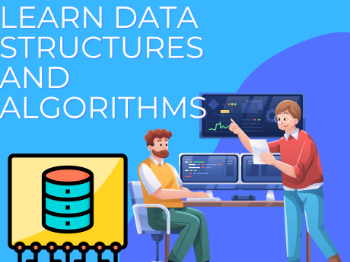Learn Data Structures and Algorithms

What will students learn in this course?
- check Learn, implement and use different Algorithms
- check Learn, implement, and use different Data Structures
- check Become a better developer by mastering computer science fundamentals
- check Ace coding interviews given by some of the top tech companies
Who is this Data Structures and Algorithms course for?
- person Any engineer, developer, programmer who wants to improve their programming skills.
What are the requirements or prerequisites for taking this course?
- arrow_right Basic programming in any of the programming language.
Projects included in this course
- arrow_right Design a map navigator using Dijkstra's algorithm .
About Course
Data structures and algorithms form the backbone of computer science. They are essential tools for organizing and manipulating data, solving complex computational problems efficiently, and designing algorithms that enable machines to solve real-world challenges.
Data structures are models that store and organize data to solve computational tasks or problems. Algorithms are procedures for solving a problem or performing a computation.
Data structures and algorithms are essential concepts for students, developers, administrators, and IT professionals in computer science. Additionally, the principles taught in data structures and algorithms have relevance to various areas beyond computer programming. This includes fields like computational geometry, optimization, and graph theory where they can be applied effectively. Furthermore, people may encounter these concepts frequently in their daily lives unknowingly - one example is search engines' use of algorithms that list the most relevant web pages within seconds after a query. Our Data Structures and Algorithms course offers an opportunity for individuals to develop a thorough understanding of these core topics within computer science.
Course Outline
Our course covers all the essential data structures and algorithms in detail.
Linear data structures: This section introduces students to the linear structure of linear lists, stacks and queues. The course extensively covers the implementation, manipulation, and utilization of these structures in solving a variety of problems.
Nonlinear data structures: This section focuses on the nonlinear structure of generalized lists, trees, and graphs. The course thoroughly explains the concepts of these data structures, including their creation and modification techniques and exploration algorithms.
Algorithm design and analysis: It is a crucial component in computer science for expanding one's academic understanding. This section teaches effective problem-solving methods, including divide-and-conquer, dynamic programming, greedy algorithms, and graph algorithms. With the application of this knowledge, students can gain practical experience to develop fast and efficient solutions to complex problems encountered while designing software systems on an advanced level.
Applications of data structures and algorithms: In this section, the course applies practical usage of data structures and algorithms beyond their theoretical concepts.
Linear Data Structures
Arrays and Linked Lists: This section covers the implementation and manipulation of arrays and linked lists.Students will learn how to access, search, insert and delete elements from both data structures.
Stacks and Queues: This section will discuss the implementation of stacks and queues as a linear data structure in detail. Students will learn how to use these data structures in achieving specific tasks, such as evaluating expressions and reversing a string.
Nonlinear Data Structures
Trees: This section covers the implementation and exploration of tree data structures including binary trees, AVL trees, red-black trees and B-trees.
Graphs: This section studies the implementation and manipulation of graphs. The course covers graph theory and introduces algorithms used to solve associated problems, such as shortest path and graph traversal.
What We Offer
We have simplified our course to ensure students receive a strong understanding of data structures and algorithms. We use a variety of teaching techniques to ensure maximum engagement and comprehension. This course offers interactive lectures, presentations and exercises to help students fully grasp the subject matter. It emphasizes practical learning that can be applied in real-life situations. Enrolling in our program offers a unique opportunity to obtain valuable skills that are applicable across various industries. The course is an essential foundation for all computer science professionals and aspiring students who aspire to design and develop sophisticated, fast, active, and stable software.